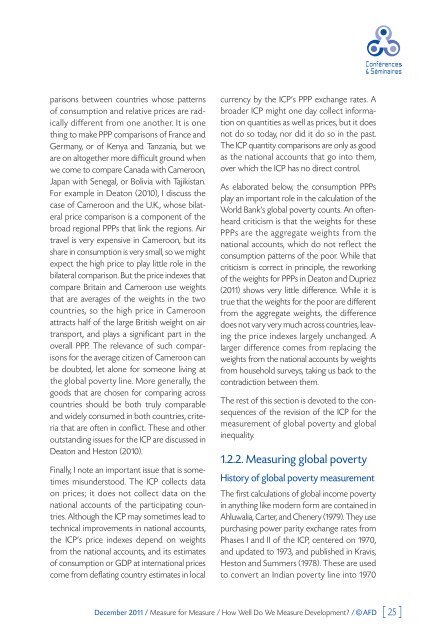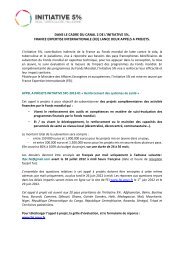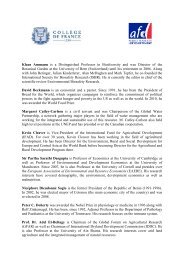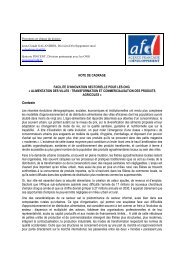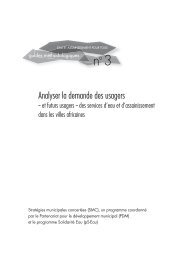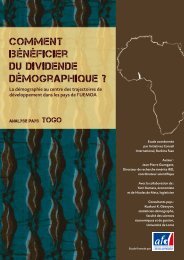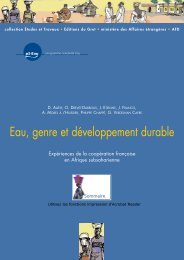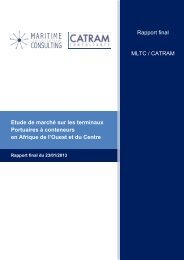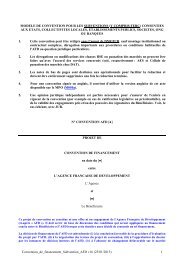Paris School of Economics - L'Agence Française de Développement
Paris School of Economics - L'Agence Française de Développement
Paris School of Economics - L'Agence Française de Développement
You also want an ePaper? Increase the reach of your titles
YUMPU automatically turns print PDFs into web optimized ePapers that Google loves.
parisons between countries whose patterns<br />
<strong>of</strong> consumption and relative prices are radically<br />
different from one another. It is one<br />
thing to make PPP comparisons <strong>of</strong> France and<br />
Germany, or <strong>of</strong> Kenya and Tanzania, but we<br />
are on altogether more difficult ground when<br />
we come to compare Canada with Cameroon,<br />
Japan with Senegal, or Bolivia with Tajikistan.<br />
For example in Deaton (2010), I discuss the<br />
case <strong>of</strong> Cameroon and the U.K., whose bilateral<br />
price comparison is a component <strong>of</strong> the<br />
broad regional PPPs that link the regions. Air<br />
travel is very expensive in Cameroon, but its<br />
share in consumption is very small, so we might<br />
expect the high price to play little role in the<br />
bilateral comparison. But the price in<strong>de</strong>xes that<br />
compare Britain and Cameroon use weights<br />
that are averages <strong>of</strong> the weights in the two<br />
countries, so the high price in Cameroon<br />
attracts half <strong>of</strong> the large British weight on air<br />
transport, and plays a significant part in the<br />
overall PPP. The relevance <strong>of</strong> such comparisons<br />
for the average citizen <strong>of</strong> Cameroon can<br />
be doubted, let alone for someone living at<br />
the global poverty line. More generally, the<br />
goods that are chosen for comparing across<br />
countries should be both truly comparable<br />
and wi<strong>de</strong>ly consumed in both countries, criteria<br />
that are <strong>of</strong>ten in conflict. These and other<br />
outstanding issues for the ICP are discussed in<br />
Deaton and Heston (2010).<br />
Finally, I note an important issue that is sometimes<br />
misun<strong>de</strong>rstood. The ICP collects data<br />
on prices; it does not collect data on the<br />
national accounts <strong>of</strong> the participating countries.<br />
Although the ICP may sometimes lead to<br />
technical improvements in national accounts,<br />
the ICP’s price in<strong>de</strong>xes <strong>de</strong>pend on weights<br />
from the national accounts, and its estimates<br />
<strong>of</strong> consumption or GDP at international prices<br />
come from <strong>de</strong>flating country estimates in local<br />
currency by the ICP’s PPP exchange rates. A<br />
broa<strong>de</strong>r ICP might one day collect information<br />
on quantities as well as prices, but it does<br />
not do so today, nor did it do so in the past.<br />
The ICP quantity comparisons are only as good<br />
as the national accounts that go into them,<br />
over which the ICP has no direct control.<br />
As elaborated below, the consumption PPPs<br />
play an important role in the calculation <strong>of</strong> the<br />
World Bank’s global poverty counts. An <strong>of</strong>tenheard<br />
criticism is that the weights for these<br />
PPPs are the aggregate weights from the<br />
national accounts, which do not reflect the<br />
consumption patterns <strong>of</strong> the poor. While that<br />
criticism is correct in principle, the reworking<br />
<strong>of</strong> the weights for PPPs in Deaton and Dupriez<br />
(2011) shows very little difference. While it is<br />
true that the weights for the poor are different<br />
from the aggregate weights, the difference<br />
does not vary very much across countries, leaving<br />
the price in<strong>de</strong>xes largely unchanged. A<br />
larger difference comes from replacing the<br />
weights from the national accounts by weights<br />
from household surveys, taking us back to the<br />
contradiction between them.<br />
The rest <strong>of</strong> this section is <strong>de</strong>voted to the consequences<br />
<strong>of</strong> the revision <strong>of</strong> the ICP for the<br />
measurement <strong>of</strong> global poverty and global<br />
inequality.<br />
1.2.2. Measuring global poverty<br />
History <strong>of</strong> global poverty measurement<br />
The first calculations <strong>of</strong> global income poverty<br />
in anything like mo<strong>de</strong>rn form are contained in<br />
Ahluwalia, Carter, and Chenery (1979). They use<br />
purchasing power parity exchange rates from<br />
Phases I and II <strong>of</strong> the ICP, centered on 1970,<br />
and updated to 1973, and published in Kravis,<br />
Heston and Summers (1978). These are used<br />
to convert an Indian poverty line into 1970<br />
December 2011 / Measure for Measure / How Well Do We Measure Development? / © AFD [ 25<br />
]


